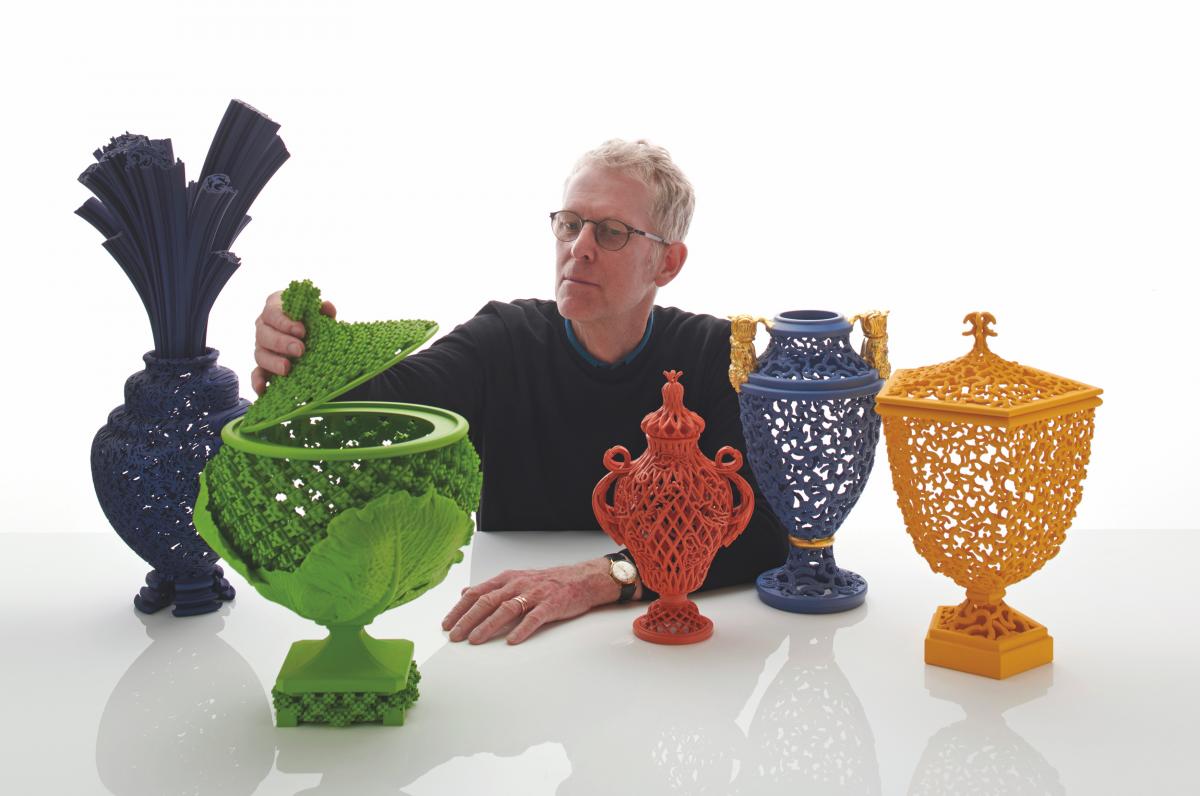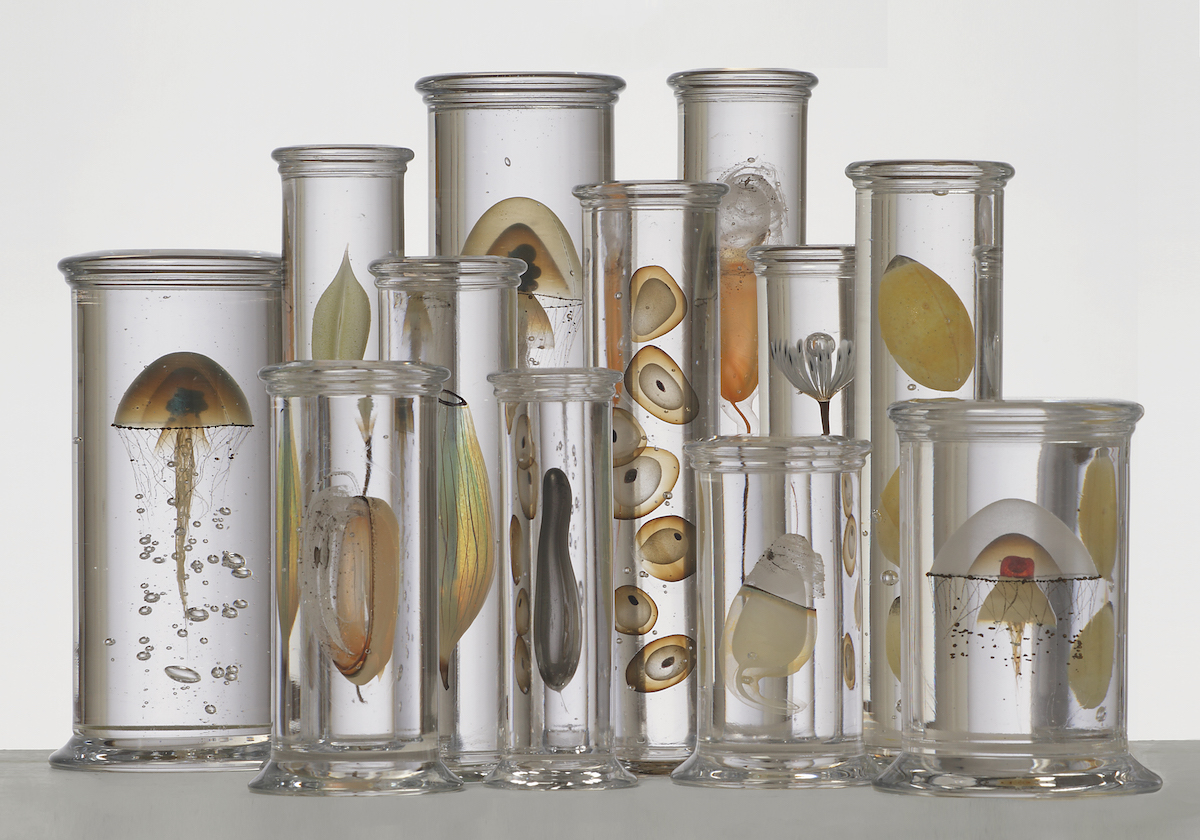This wonderful Cornish workshop and museum is dedicated to the legacy of studio pottery trailblazer Bernard Leach
The Rise and Rise of Craft
The Rise and Rise of Craft
7 Dec 2020
A new survey reveals that our collective interest in craft is soaring. What lies behind this surge?
 Michael Eden with a selection of works created using 3D printing. Image Courtesy of Adrian Sassoon, London
Michael Eden with a selection of works created using 3D printing. Image Courtesy of Adrian Sassoon, London
William Morris would be pleased. More than 140 years after the advocate for craft exhorted us to ‘have nothing in your houses that you do not know to be useful, or believe to be beautiful’, we seem – at last – to be taking note. A Crafts Council survey, the Market for Craft report, reveals 73% of UK adults bought craft in 2019, snapping up almost 25 million handmade objects. This year’s sales were predicted to exceed £3bn before Covid-19. In 2011 that figure was £1bn. ‘There are a number of reasons behind this,’ asserts Crafts Council director Rosy Greenlees. ‘People are increasingly interested in acquiring pieces that reflect their personality, and craft is about individuality – crafted objects are either unique or made in small batches.’
Marking a significant shift, almost a third of those buying are aged under 35. Social media is a big part of this, as digital natives use their media savviness to promote handmade wares. These range from the affordable and everyday through to high-end offerings from galleries. At both ends of the spectrum, e-commerce is thriving. Over 10 million of us are buying craft online: a figure that has more than tripled over the past decade.
Eleanor Lakelin’s 110cm-high Echoes of Amphora: Column Vessels, 2019, made from horse chestnut burr. The artist uses only wood from British trees that have been felled due to decay. Photo: © Michael Harvey 2017. Image courtesy Sarah Myserscough Gallery
BOUNDARY BREAKERS
Far from leaning on craft heritage alone, makers are innovating – exploring the ways, for instance, that technology and tradition can combine. Maker Michael Eden creates dazzling sculptural vessels that marry 3D printing and ceramics skills. Designer-maker Gareth Neal produces furniture using both woodworking skills and CNC (computer numerical control) machines. Clearly, the current rise of craft cannot be dismissed as folksy nostalgia alone. Others continue to create tactile objects that encourage the viewer to feel. Wood artist Eleanor Lakelin’s lathe-turned vessels are a perfect example: bleached bone-white or ebonised to a silky black, their surfaces beg to be stroked. While most craft is free from contemporary art’s conceptual underpinnings, it is never short of simple pleasure.
 Glassmaker Steffen Dam’s surreal hand-blown and cast glass Marine Life and Jellyfish Jars. Image from Joanna Bird
Glassmaker Steffen Dam’s surreal hand-blown and cast glass Marine Life and Jellyfish Jars. Image from Joanna Bird
Such skilfully worked objects, perfected through patient study, are one source of satisfaction. Then there are those that come from makers who push the boundaries of what we once defined as ‘craft’. Glass artist Steffen Dam creates complex sculptures, magicking imaginary sea creatures from molten glass and arranging them into cabinets of curiosity. Artist Rowan Mersh sews together thousands of hand-cut seashells to create delicate, net-like sculptures. Weaver Ptolemy Mann creates painterly textiles so vivid they appear to throb with inner life. The mesmerising quality of these objects comes from both their beauty and their mastery. Each is the antithesis of an object made in its millions in sweatshop conditions. Craft brings beauty to our homes, without the hangover of consumer guilt.
One reason craft is thriving online is – somewhat paradoxically – its material nature. In this world of mechanised mass production and its resulting homogeneity, unique handmade objects appear ever more intriguing. This allure is enhanced when accompanied by stories of maker and making, which is where social media shines. It’s the combination of craft’s two parallel aspects – of both material and narrative qualities – that work so successfully online. ‘It’s a moment where the digital and the physical are working together in a positive way for craft,’ reflects Greenlees. ‘There was obsession in the early 2000s with digital technology being the be-all and end-all; the rise in craft is an interesting reaction to this. People have become re-engaged in the value of physical things again.’
Textile artist Ptolemy Mann’s Circadian Rhythm, 2019, Daylight. Tate Commission, detail
LENDING SUPPORT
Despite this boom in public interest, craft can be a financially perilous career choice. ‘My view is that unless people can make a living, particular skills are going to die out,’ says Arts Society volunteer Pat Wood, who has long been involved, via the Grants Committee and the Greater London Area, with the Cockpit Arts/The Arts Society Award. She adds: ‘We’ve helped craftspeople make their business viable. The award is a bursary of £3,000 towards a year in a studio. We also help stone carvers at City & Guilds, give student bursaries for the Royal School of Needlework and support Koestler Arts, which brings handmaking into prisons.’
Support from bodies such as The Arts Society is vital for emerging craftspeople. It’s also clear that making is attracting more and more of us. This is borne out by viewing figures for craft-based shows. The BBC’s The Great British Sewing Bee shifted to a prime-time slot with audiences of over four million, while a public petition helped bring The Great Pottery Throw Down back on- screen. The Market for Craft report shows that 20% of British consumers would pay to attend a craft workshop. Hobbycraft has seen a 200% increase in online sales since the pandemic began. Now Covid-19 has ushered in an age of living life digitally, the need for craft will likely increase, offering the digital-weary a chance to unplug and regroup, as repetitive actions offer a meditative space conducive to mental wellbeing.
The Arts Society's Patricia Fay Memorial Fund Award enabled jeweller Meron Wolde to work in a funded Cockpit Arts studio
THE BOON OF BENEFITS
While sales are booming, education is a different story. Art, craft and design offer opportunities for children less suited to academic subjects who have potential to soar within the creative industries. ‘Nevertheless, craft is increasingly excluded from the national curriculum,’ states Michele Gregson of the National Society for Education in Art and Design. ‘Yet a good craft education matters. Every child should get the benefits of making: whether that’s wellbeing, career choices, being part of your heritage or developing fine motor skills.’ That latter point is another growing cause for concern. As Gregson pithily puts it: ‘If you don’t think craft matters, just think about the surgeon stitching you up. What kind of hand skills do they have?’ Professor Roger Kneebone of Imperial College London has spoken out on trainee surgeons who ‘can’t sew or cut’, for which he blames excessive tapping of the 2D surface of screens, rather than handling materials.
‘NOW COVID-19 HAS USHERED IN AN AGE OF LIVING LIFE DIGITALLY, THE NEED FOR CRAFT WILL LIKELY INCREASE, OFFERING THE DIGITAL-WEARY A CHANCE TO UNPLUG AND REGROUP, AS REPETITIVE ACTIONS OFFER A MEDITATIVE SPACE CONDUCIVE TO MENTAL WELLBEING’
‘The pandemic has not only increased the (already excessive) amount of time people are spending on-screen; it’s also shown how dangerous it is to rely exclusively on far-flung, exploitative systems of production and distribution,’ says craft critic Glenn Adamson. There’s a sustainability angle to the rise of craft, too, as growing numbers of people wish to buy well – choosing investment purchases over throwaway objects. He adds: ‘Craft cannot be the sole solution to these problems, but it is a key part of the more holistic, ecological and locally oriented culture we’ll need to build coming out of this crisis.’ It’s a heartening thought. Craft, and the power of craftspeople to innovate, surprise and bring joy, may just help us thread our way through these troubling times.
Isabella Smith is assistant editor of Crafts magazine
This feature originally appeared in the winter 2020 edition of The Arts Society Magazine, available exclusively to Members and Supporters.
About the Author
Isabella Smith
JOIN OUR MAILING LIST
Become an instant expert!
Find out more about the arts by becoming a Supporter of The Arts Society.
For just £20 a year you will receive invitations to exclusive member events and courses, special offers and concessions, our regular newsletter and our beautiful arts magazine, full of news, views, events and artist profiles.
FIND YOUR NEAREST SOCIETY
MORE FEATURES
Ever wanted to write a crime novel? As Britain’s annual crime writing festival opens, we uncover some top leads
It’s just 10 days until the Summer Olympic Games open in Paris. To mark the moment, Simon Inglis reveals how art and design play a key part in this, the world’s most spectacular multi-sport competition






